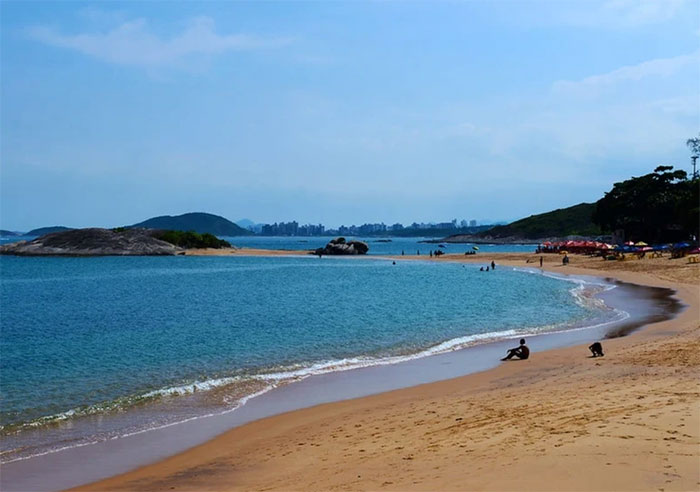The Areia Preta beach in Guarapari (Brazil) is famous not for being an ideal tourist destination, but for its radiation levels that are nearly 400 times higher than the normal standard.
Brazil is a country renowned for its “blue seas and white sands”, with hundreds of kilometers of coastline attracting tourists from all over the world. However, no beach is quite like Praia Da Areia Preta in Guarapari.

Areia Preta beach with gamma radiation that poses serious danger to tourists. (Photo: AP).
It is unclear when it was first noticed, but the sand in this area, especially the black sand, contains a high amount of monazite – a mineral rich in phosphate, along with some rare earth elements, including uranium and thorium.
Research has shown that the background radiation at Areia Preta can reach up to 175 mSv per year, or 20 μSv/h, while some spots, particularly those covered by black sand, have radiation levels of up to 55 μSv/h.
For comparison, the average radiation exposure across the United States is about 0.34 μSv/h. Meanwhile, an X-ray exposes a person to approximately 100 μSv of radiation.
Where does the black sand at Areia Preta beach come from?
The black sand rich in monazite in the Guarapari region was first noted in 1880 by Austrian scientist Carl Auer von Welsbach. At that time, he was searching for thorium material for his newly invented incandescent lamp filaments, and monazite sand was seen as a perfect source.
Scientists believe that ocean waves continuously crash against monazite-rich coastal mountains, and some radioactive compounds have washed ashore in the form of black sand. This is why the beaches in Guarapari have this special sand.
In 1972, the therapeutic applications of monazite sand were first introduced by Dr. Silva Mello. At that time, a therapy called “radioactive sand,” which she claimed could treat various health issues, including arthritis, gained attention.
As a result, to this day, thousands of tourists flock to these unique beaches, hoping to heal by lying on or even covering themselves with the radioactive sand, ignoring the dangers of prolonged exposure to radiation.
Is radioactive sand dangerous?

Studies suggest that gamma radiation levels on Areia Preta beach are equivalent to the vicinity (about 1 square kilometer) of the Chernobyl nuclear power plant.
Fifty years after Dr. Silva Mello’s announcement regarding the benefits of monazite sand, many people in Brazil still believe that exposure to the sand is actually good for their health. The tourism industry in Guarapari has certainly benefited from this narrative, and the city proudly carries the nickname “The Healthy City,” despite the controversies surrounding the effects of sand exposure.
It is known that most areas in Guarapari have relatively low background radiation levels, averaging 0.6 μSv/h, which does not pose any health threats. However, beaches like Areia Preta are a completely different matter.
For many years, research has shown that the gamma radiation alone on Areia Preta beach is enough to pose serious dangers to tourists.
A 2002 study indicated that the gamma radiation levels on Areia Preta beach are comparable to those in the vicinity (about 1 square kilometer) of the Chernobyl nuclear power plant.
The authors of the study pointed out that although the radioactive nuclear components at the two sites are certainly different, the gamma radiation at Areia Preta necessitates protective equipment for anyone visiting the area.
According to reports, radiation absorbed through the skin can increase the risk of skin cancer, while inhaled radioactive compounds can cause lung cancer. For these reasons, the Brazilian Nuclear Agency has not recommended that tourists spend too much time on radioactive beaches like Areia Preta.


















































